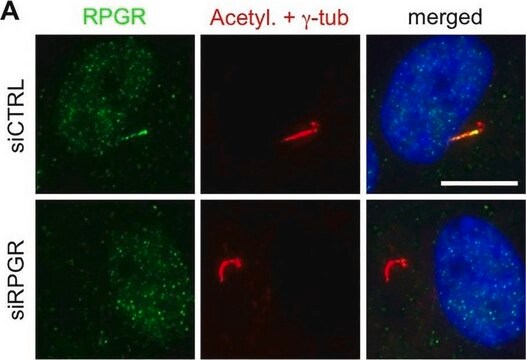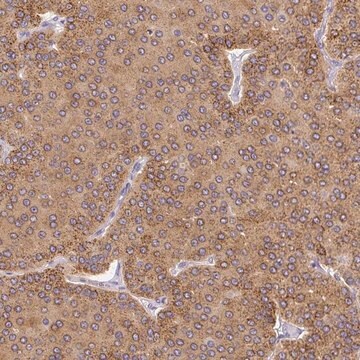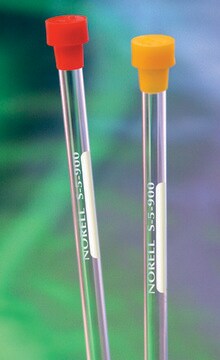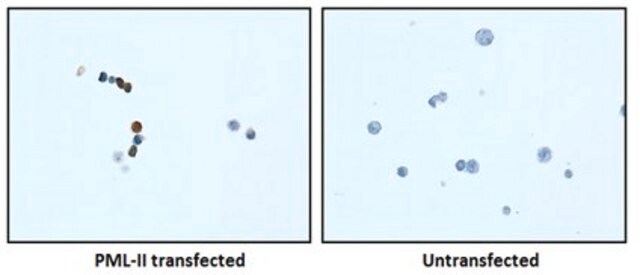MAB3747-I
Anti-Microphthalmia (Mi) Antibody, clone C5
clone C5, from mouse
Synonym(s):
Microphthalmia-associated transcription factor, Class E basic helix-loop-helix protein 32, bHLHe32
About This Item
Recommended Products
biological source
mouse
Quality Level
antibody form
purified immunoglobulin
antibody product type
primary antibodies
clone
C5, monoclonal
species reactivity
mouse, human
species reactivity (predicted by homology)
rat
technique(s)
electrophoretic mobility shift assay: suitable
immunocytochemistry: suitable
immunofluorescence: suitable
immunohistochemistry: suitable
immunoprecipitation (IP): suitable
western blot: suitable
isotype
IgG2aκ
NCBI accession no.
UniProt accession no.
shipped in
wet ice
target post-translational modification
unmodified
Gene Information
human ... MITF(4286)
General description
Specificity
Immunogen
Application
Immunocytochemistry Analysis: A representative lot detected the exogenously expressed murine microphthalmia mutant constructs, Mitf D222/236N and Mitf D222N (mi-vit), in the nucleus of transfected COS-7 cells. Dual staining showed much reduced β-catenin-anchoring ability of these mutants in the nucleus (Schepsky, A., et al. (2006). Mol. Cell. Biol. 26(23): 8914-8927).
Immunocytochemistry Analysis: A representative lot detected a time-dependent induction of microphthalmia upregulation in B16/F10 murine melanoma cells upon Forskolin stimulation by fluorescent immunocytochemistry (Bertolotto, C., et al. (1998). J. Cell Biol. 142(3):827-835).
Electrophoretic Mobility Shift Assay (EMSA): A representative lot caused a supershift of Mbox motif oligonucleotide-complexed wild-type and D222/236N and D222N mutant murine microphthalmia constructs by EMSA (Schepsky, A., et al. (2006). Mol. Cell. Biol. 26(23): 8914-8927).
Electrophoretic Mobility Shift Assay (EMSA): A representative lot caused a supershift of Mbox motif oligonucleotide-complexed microphthalmia, but not TFE3-DNA complex by EMSA using in vitro translated microphthalmia and TFE3 or B16/F10 murine melanoma cell nuclear extract (Verastegui, C., et al. (2000). Mol. Endocrinol. 14(3):449-456).
Immunoprecipitation Analysis: A representative lot immunoprecipitated microphthalmia from B16/F10 murine melanoma cell nuclear extracts (Verastegui, C., et al. (2000). Mol. Endocrinol. 14(3):449-456).
Western Blotting Analysis: A representative lot detected microphthalmia expression in murine splenocytes and B16/F10 murine melanoma cells (Verastegui, C., et al. (2000). Mol. Endocrinol. 14(3):449-456).
Western Blotting Analysis: A representative lot detected a time-dependent induction of microphthalmia upregulation in B16/F10 murine melanoma cells and normal human melanocytes upon stimulation by Forskolin or α-melanocyte–stimulating hormone (αMSH) (Bertolotto, C., et al. (1998). J. Cell Biol. 142(3):827-835).
Quality
Western Blotting Analysis: An 1:500 dilution of this antibody detected Microphthalmia in 10 µg of mouse brain tissue lysate.
Target description
Physical form
Analysis Note
Mouse brain tissue lysates
Other Notes
Not finding the right product?
Try our Product Selector Tool.
recommended
Storage Class Code
12 - Non Combustible Liquids
WGK
WGK 1
Flash Point(F)
Not applicable
Flash Point(C)
Not applicable
Regulatory Listings
Regulatory Listings are mainly provided for chemical products. Only limited information can be provided here for non-chemical products. No entry means none of the components are listed. It is the user’s obligation to ensure the safe and legal use of the product.
JAN Code
MAB3747-I:
Certificates of Analysis (COA)
Search for Certificates of Analysis (COA) by entering the products Lot/Batch Number. Lot and Batch Numbers can be found on a product’s label following the words ‘Lot’ or ‘Batch’.
Already Own This Product?
Find documentation for the products that you have recently purchased in the Document Library.
Our team of scientists has experience in all areas of research including Life Science, Material Science, Chemical Synthesis, Chromatography, Analytical and many others.
Contact Technical Service







